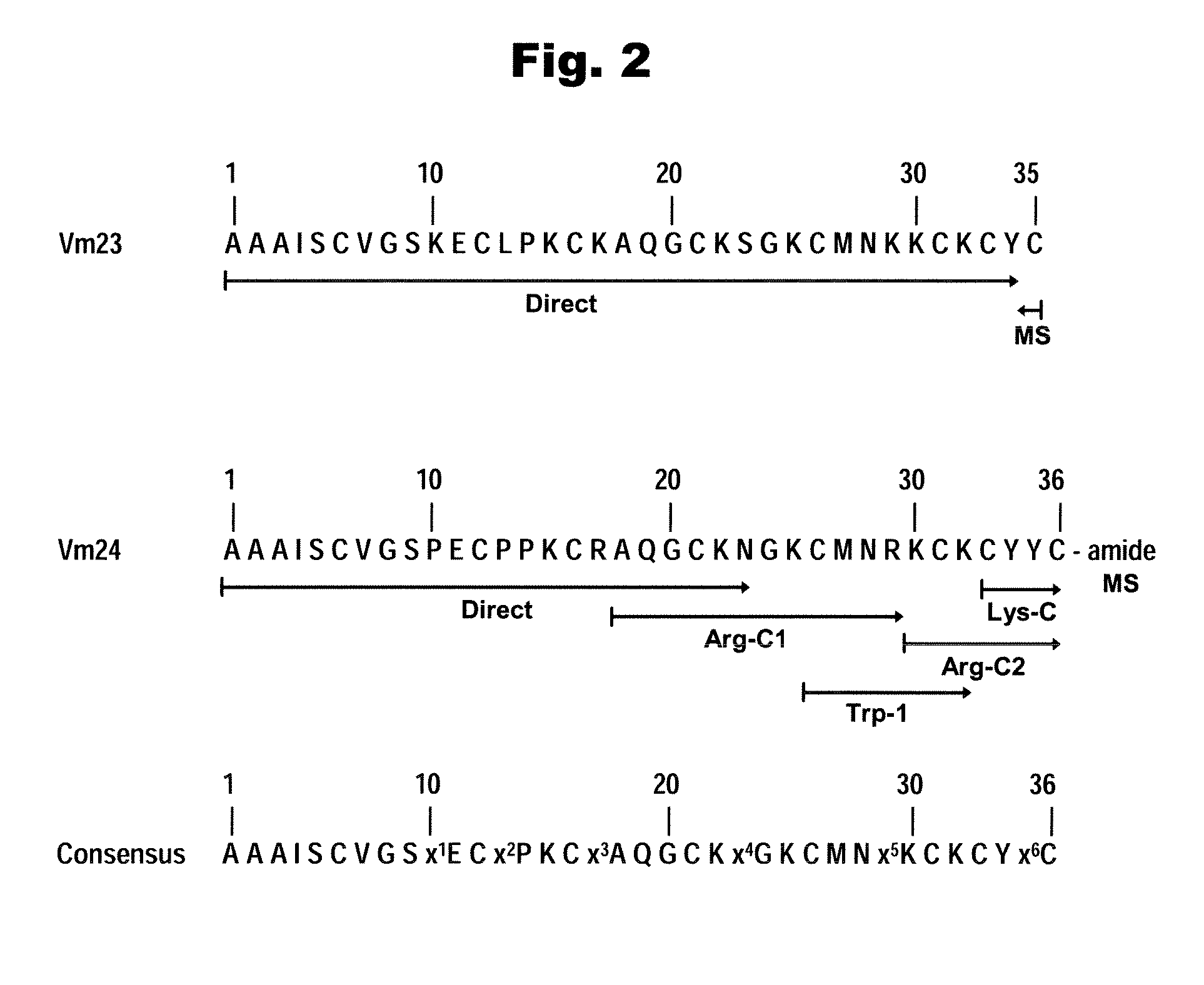Vm23 and Vm24, two scorpion peptides that block human T-lymphocyte potassium channels (sub-type Kv1.3) with high selectivity and decrease the in vivo DTH-responses in rats
a potassium channel and scorpion peptide technology, applied in the field of biochemistry, molecular biology, immunology and electrophysiology, can solve the problems of lack of specificity and affinity, and the blockage of kv1.3 channels in cells may give rise to considerable side effects, and achieve high affinity for hkv1.3 channels, not toxic, and high specificity.
- Summary
- Abstract
- Description
- Claims
- Application Information
AI Technical Summary
Benefits of technology
Problems solved by technology
Method used
Image
Examples
example 1
Isolation, Lethality Test in Mice and Primary Structure Determination of Vm23 and Vm24
[0123]All solvents and chemicals used were analytical grade and double-distilled water was used throughout the procedure as earlier described [Batista et al., 2007].
Isolation Procedures
[0124]The procedures used for isolation of the various natural ligands mentioned above make use of chromatographic techniques. The venom was solubilized in water and centrifuged at 10,000×g for 5 min. The supernatant was recovered and separated by high performance liquid chromatography (HPLC). One hundred microliter containing 1.0 milligram of the soluble venom protein was applied to an analytical C18 reverse-phase column (dimensions 10×250 mm, catalog number 238TP) obtained from Vydac (Hisperia, Calif., USA), of a HPLC system (Millenium Millipore, Milford, Mass.). Components were purified using a linear gradient from solution A (0.12% trifluoroacetic acid—TFA in water) to 60% solution B (0.10% TFA in acetonitrile), ...
example 2
Mass Finger Print Analysis of the Components Present in the Venom of V. mexicanus
[0136]Scorpion venoms are highly complex mixtures of components, comprising short and long-chain peptides active on ion-channels (reviewed in [Possani and Rodriguez de la Vega, 2006]), free amines, nucleotides, carbohydrates, lipids (reviewed in Possani et al., 1999), enzymes such as phospholipases [Zamudio et al., 1997: Valdez et al., 2004], hyaluronidases and lysozymes [Batista et al., 2007] and many other protein components of unknown function [Diego-Garcia et al., 2007]. Additionally, scorpions are very ancient creatures with more than three hundred million years of evolution on the surface of the Earth and have had time to select specific tools for hunting their preys or for defending themselves from predators. For these reasons it is appealing and wise to search for the presence of biologically active components in their venoms. Thanks to the recent advancement on mass spectrometry methodologies ...
example 3
Characterization of the C-Terminal Amino Acid Sequence of Vm23 and Vm24
[0140]Concerning the last residue at the C-terminal amino acid sequence of Vm23 the results are clear. The sequence analysis described in example 1 of this disclosure, whose sequence is shown in FIG. 2, leaves little doubt that the last residue is not amidated and terminates the primary structure with a free carboxyl cysteine residue.
[0141]However, for Vm24 the mass spectrometry results suggest that the C-terminal residue could be amidated. The literature reports examples where the amidation of the last amino acid of a given peptide is important for defining its biological function. One such example is the case found for toxin HsTx1 of the scorpion Heterometrus spinnifer [Lebrun et al., 1997]. Electrophysiological experiments have demonstrated that the amidated form of this toxin is 5-fold more potent than the free-carboxyl-terminal form and it is up to 300-fold more active in binding experiments to rat brain syn...
PUM
| Property | Measurement | Unit |
|---|---|---|
| membrane potential | aaaaa | aaaaa |
| membrane potential | aaaaa | aaaaa |
| body weight | aaaaa | aaaaa |
Abstract
Description
Claims
Application Information
 Login to View More
Login to View More - R&D
- Intellectual Property
- Life Sciences
- Materials
- Tech Scout
- Unparalleled Data Quality
- Higher Quality Content
- 60% Fewer Hallucinations
Browse by: Latest US Patents, China's latest patents, Technical Efficacy Thesaurus, Application Domain, Technology Topic, Popular Technical Reports.
© 2025 PatSnap. All rights reserved.Legal|Privacy policy|Modern Slavery Act Transparency Statement|Sitemap|About US| Contact US: help@patsnap.com



